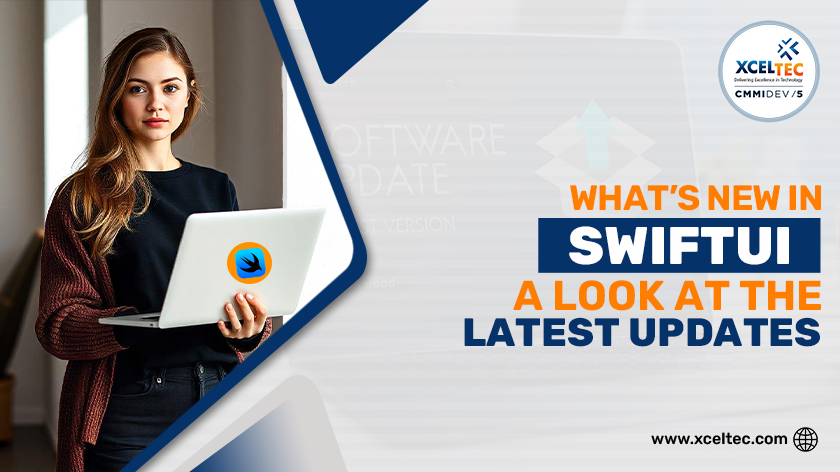
What’s New in SwiftUI: A Look at the Latest Updates
SwiftUI, Apple’s powerful framework for building user interfaces across all Apple platforms, continues to evolve with each new version. The latest update introduces several exciting capabilities that further enhance the development process, improve performance, and make building intuitive user interfaces even easier. From improved charting tools to seamless integration with UIKit components and more robust support for animations and gestures, SwiftUI is pushing the boundaries of what developers can achieve.
Let’s dive into the new features that make SwiftUI even more powerful for 2024.
1. Improved Charting Tools
One of the most notable updates in SwiftUI is the introduction of enhanced charting tools. Developers can now create sophisticated, interactive charts with ease, making data visualization more intuitive.
Customizable Chart Types: SwiftUI now offers a variety of chart types such as bar, line, and pie charts, which can be customized to fit your design requirements.
Interactive Elements: New interactive chart features allow users to hover, click, or tap on chart elements for a richer, more engaging experience.
Integration with Data Sources: SwiftUI’s charts can seamlessly integrate with data from both local and remote sources, making it easy to display real-time information in a visually appealing manner.
These enhancements make it simpler for developers to create data-driven apps with complex charting features while keeping the user interface clean and responsive.
2. Better Integration with UIKit Components
While SwiftUI is Apple’s preferred framework for building modern user interfaces, many developers still rely on UIKit for legacy projects or for components that are not yet available in SwiftUI. The latest version of SwiftUI significantly improves its integration with UIKit, providing more flexibility and enabling smoother transitions between the two frameworks.
Bridging UIKit and SwiftUI: SwiftUI now makes it easier to embed UIKit views inside SwiftUI layouts, and vice versa, without cumbersome workarounds. This opens up opportunities to reuse existing UIKit components while building new SwiftUI-based UIs.
Improved Navigation and Modals: The interaction between SwiftUI and UIKit has been enhanced, allowing for more seamless management of navigation controllers, modal presentations, and other UIKit-based behaviors within a SwiftUI context.
This improvement ensures developers can take advantage of both SwiftUI and UIKit, leveraging the strengths of each framework without sacrificing performance or user experience.
3. Enhanced Support for Animations
Animations are a core part of user interfaces, and SwiftUI has always made it easy to animate views and transitions. However, with the new update, SwiftUI introduces even more powerful and intuitive animation features.
Declarative Animation Syntax: The declarative syntax for animations in SwiftUI is more powerful, enabling smoother transitions and more complex animations with less code.
Enhanced Timing and Easing Functions: Developers now have access to more advanced timing and easing functions, allowing for greater control over how animations feel.
Implicit and Explicit Animations: The framework improves both implicit and explicit animations, giving developers the flexibility to choose the most suitable method for their specific use case.
With these improvements, SwiftUI enables more dynamic and fluid user experiences, making animations an even more integral part of the development process.
4. Improved Gestures and Interaction Handling
SwiftUI 2024 makes gestures easier to implement and more responsive, which is crucial for creating interactive apps with smooth user interactions.
Gesture Modifiers: SwiftUI now supports more fine-grained gesture modifiers, allowing developers to respond to taps, swipes, pinches, and rotations with greater precision.
Enhanced Gesture Recognition: The update improves the framework’s ability to recognize multiple gestures simultaneously, allowing developers to build more complex interactions, such as pinch-to-zoom with swipe gestures.
Contextual Gestures: SwiftUI now supports gestures that respond based on contextual awareness, providing a more intuitive user experience. For example, you can create gestures that change depending on the view’s state or the device’s orientation.
These new capabilities make it easier to build applications that feel responsive and intuitive, improving user engagement.
5. New and Enhanced View Types
SwiftUI 2024 also introduces a set of new and enhanced view types to make building user interfaces more powerful and flexible.
Grid and List Improvements: With improvements to the
GridandListviews, developers can now create more complex layouts with less code, while ensuring great performance even when displaying large sets of data.Custom Views and Modifiers: SwiftUI now includes more options for creating custom views and modifiers, which helps developers maintain a consistent design throughout their apps while allowing for extensive customization.
These new views and layout components offer greater control over app design, making it easier to create more sophisticated and flexible interfaces.
6. Live Preview Updates
SwiftUI’s live preview feature is one of its most appreciated tools, allowing developers to instantly see changes as they code. The latest improvements to live previews enhance the development experience even further.
Faster Previews: Previews now load faster, making the design iteration process smoother.
Interactive Previews: Developers can now interact with their live previews in a more dynamic way, providing a real-time representation of how their app will behave once it’s built.
This feature accelerates the development cycle by reducing the need for constant rebuilding, thus improving workflow and productivity.
Conclusion
SwiftUI continues to evolve, offering more powerful tools to developers for creating modern, dynamic user interfaces. With new features like improved charting tools, better UIKit integration, enhanced animations and gestures, and refined view types, SwiftUI provides an even more robust framework for iOS, macOS, watchOS, and tvOS development in 2024. These updates not only improve developer productivity but also ensure that users get a richer, more intuitive experience on their Apple devices.
At XcelTec, we stay ahead of the curve by adopting the latest advancements in SwiftUI to create cutting-edge iOS applications that provide excellent user experiences. If you’re looking to develop an intuitive, dynamic app, our team of skilled SwiftUI developers can help bring your vision to life using the latest features and best practices.







